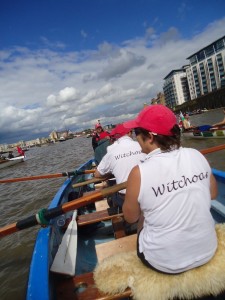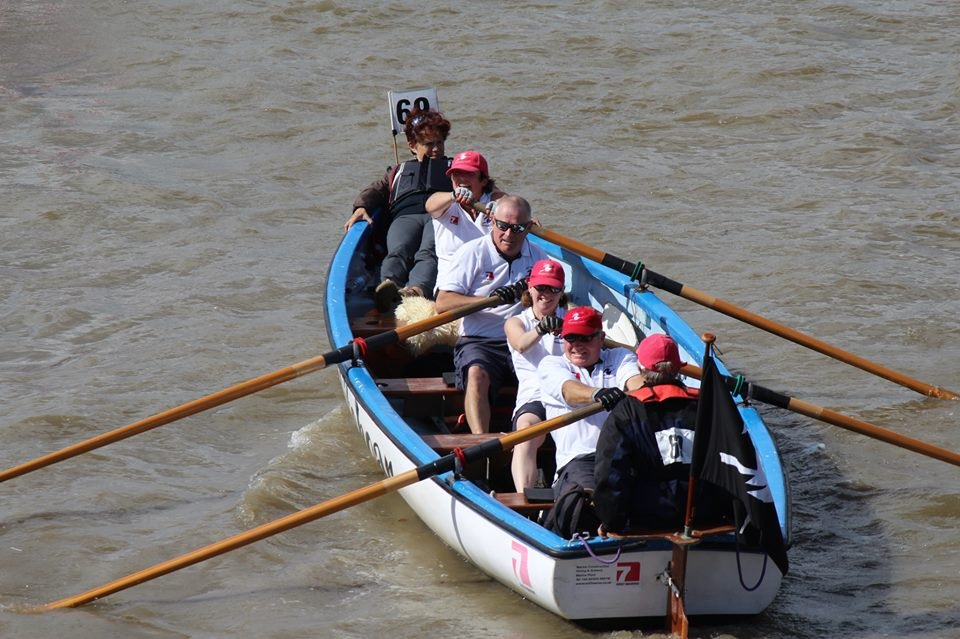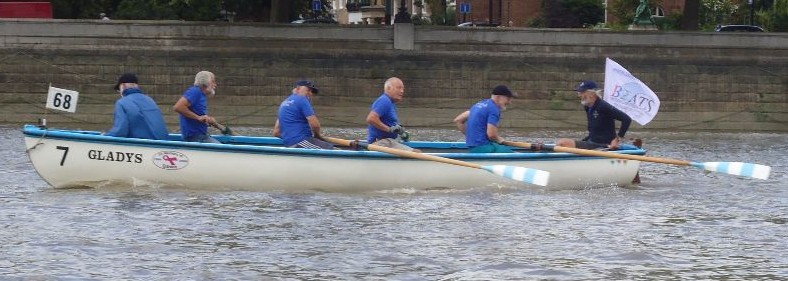On the 7 September 2013 the crew of Witchoar again took part in the Great River Race, a 21 miles rowing marathon from Docklands to Richmond. Since moving to Manningtree at the end of 2008 the boat has taken part in the race every year. This year was the fourth in a row for a veteran mixed crew of Bob Leeds, Will Langton, Sharon Robinson, Caroline Cunningham and our Cox Philip Cunningham. Contrary to all sense and reason the crew row Witchoar ‘cack-handed’ with the two men on the port side and two women on the starboard side. Despite the height and weight differential we make it work and have rarely been beaten by another Claydon skiff crew – even a men’s crew – for some while – except in the river race, where we had come second for the last two years to Gladys from the Langstone Cutters based on Hayling Island. Their average age is greater than Witchoar’s but their average height and power to weight ratio is much higher (grrr!).
Three hundred and thirty one boats of all different shapes and sizes took part in this year’s race. To take part each boat has to have to have fixed seats, at least four oars, a Coxswain, and fly a flag from the stern. The rules of the race also require each boat has a passenger as a reminder of the days when rowing boats were the water taxis of the age. Sonia Da Silva joined us for the second year with a brief to charm slower boats out of our way.
The start of the race is always chaotic with over three hundred boats in a short stretch of river, and an excess of anxiety and adrenalin. The slowest boats go off first, and there is always a huge amount of jostling for position. The tide on the Thames runs fast, and boats caught unawares find themselves carried too fast towards the start. Witchoar is a ‘Claydon’ Skiff, based on an original Thames working boat she is over 22 feet long and weighs around four hundred kilos, with four thirteen foot long wooden oars. In short she weighs half a ton without the crew and is built for everything except speed, so we were one of the earlier boats away with a race number of 69.
 There were around twenty boats with the same start time as us – all fighting the tide squeezed on the start line between the shore and the other end marked by the steel Thames sailing barge ‘Adieu’ , built by Horlocks at Mistley in 1929. We found ourselves caught between a rock and a hard place – well all of the other boats and the barge. When the call came for us to go there was no room to put an oar in the water on the starboard (the girls side). As we started to move Sharon’s oar decided to make a bid for freedom and managed to escape the boat into the water – only to be retrieved through quick action by Philip and Will who managed to haul it back without capsizing the boat. Amazingly, in a feat of scientific coolness Sharon re-located the oar in the rowlock, we pulled hard and still managed to cross the line ahead of the other Claydon skiffs , with cheers from the starters on board ‘Adieu’ for our deft oar retrieving skills
There were around twenty boats with the same start time as us – all fighting the tide squeezed on the start line between the shore and the other end marked by the steel Thames sailing barge ‘Adieu’ , built by Horlocks at Mistley in 1929. We found ourselves caught between a rock and a hard place – well all of the other boats and the barge. When the call came for us to go there was no room to put an oar in the water on the starboard (the girls side). As we started to move Sharon’s oar decided to make a bid for freedom and managed to escape the boat into the water – only to be retrieved through quick action by Philip and Will who managed to haul it back without capsizing the boat. Amazingly, in a feat of scientific coolness Sharon re-located the oar in the rowlock, we pulled hard and still managed to cross the line ahead of the other Claydon skiffs , with cheers from the starters on board ‘Adieu’ for our deft oar retrieving skills
The beginning of the race is always exciting, the waters are rough, and there are many different types of boats in a short stretch of water, squeezed over to the starboard traffic lane by the safety and harbour master boats. This is the time to keep ahead of rivals and begin to over haul boats that started ahead of us in what is effectively a pursuit race. For a long stretch we kept the other Claydons’ behind us, but we couldn’t lose them. About five miles out it was clear that Gladys just had the edge on us and their men’s team eventually pulled past us just after Waterloo Bridge, clearly enjoying every second.
At this point we were a little dispirited but our Cox told us that anything could happen in the next two hours and to keep rowing. Rowing is a funny thing – there are not many sports where you sit down and go backwards, not seeing where you are going. After another half an hour or so, our Cox shouted that Gladys was in trouble and had lost her flag and possibly her rudder as she was going round in circles. Obviously we were saddened by this change in fortune, and rowed hard to feign a rescue, then rowed straight past leaving her dead in the water. We managed to make a bit of ground before Gladys was on the move again, flag and rudder restored. Later we found that she had encountered a large piece of wood, part of the flotsam on the Thames. We stayed ahead for a while, but sadly for us Gladys’s men’s crew still had a marginal edge on us in terms of speed, and came past us again.
Our task for the rest of the race was to stay ahead of Gladys’s sister boat Mabel, also with a men’s crew, and in truth we caught not a glimpse of them until after the finish. We were helped in our endeavours by healthy competition from a ‘super raft’ paddled by the ‘Wonder Y Women’ who started two minutes ahead of us and were obviously well matched on handicap. We passed them, but they threatened several times to come back at us, counting strokes all the time from one to nine then shouting ‘Ten!’ and switching their paddles to the other side – not quite traditional rowing – but they gave us a race and an incentive to row hard and keep ahead.
Along the way our small, but noisy fan club greeted us from various bridges, and were waiting for us at river side pub at Richmond to cheer us on for the last mile or so, and then raced to greet us at the finish. We finished ahead of the raft but behind Gladys, and were once again the second Claydon Skiff home, greeted by cannon fire across the line, and chaos at the finish. There we were able to astonish rival crews with our toughness by enlisting them to haul Witchoar out of the water and on to her trailer – prompting questions of ‘what sort of boat did you say this was?’ and ‘You rowed this?’ and ‘Why?’ It was also a chance to meet up with other boats and crews that we see during the year, including at the Paddle and Oar festival, with crews from Brightlingsea, Rowhedge, and Lower Thames all represented.
In the end we came home in under 3 hrs for the first time, and although we came home second, we did ourselves and the Stour Sailing Club proud, raising over £600 for CRUK. After the race there was a chance to join our shore crew who had magically acquired tables, chairs and beer, to de-brief and to plot next year’s battle (rumour has it that Witchoar might be in the market for a couple of tall fit over sixty men who would be willing to train for a year to compete next time around – interested parties please put in a word!)


